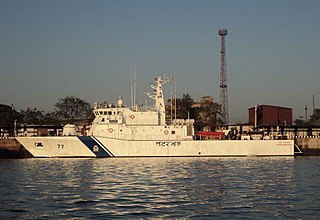Related Research Articles

The TTSeawise Giant—earlier Oppama; later Happy Giant, Jahre Viking, Knock Nevis, and Mont—was a ULCC supertanker that was the longest self-propelled ship in history, built in 1974–1979 by Sumitomo Heavy Industries in Yokosuka, Kanagawa, Japan. It possessed the greatest deadweight tonnage ever recorded. Fully laden, its displacement was 657,019 tonnes.

A cargo ship or freighter is a merchant ship that carries cargo, goods, and materials from one port to another. Thousands of cargo carriers ply the world's seas and oceans each year, handling the bulk of international trade. Cargo ships are usually specially designed for the task, often being equipped with cranes and other mechanisms to load and unload, and come in all sizes. Today, they are almost always built of welded steel, and with some exceptions generally have a life expectancy of 25 to 30 years before being scrapped.

The Durance class is a series of multi-product replenishment oilers, originally designed and built for service in the French Navy. Besides the five ships built for the French Navy, a sixth was built for the Royal Australian Navy, while the lead ship of the class currently serves with the Argentine Navy. Two ships of a similar but smaller design are in service with the Royal Saudi Navy as the Boraida-class replenishment oilers.

The Type 704 Rhön-class tankers are a series of replenishment oilers used by the German Navy to provide underway replenishment for its ships at sea. The two vessels in the class, Rhön and Spessart, were originally constructed for Libya by Kröger Shipyard in Rendsburg, West Germany as bulk acid carriers. They were acquired by the West German Navy in 1976 for conversion and entered service in 1977. The two ships are crewed by civilians. In 2019 it was announced by the German Navy that the ships are planned to be replaced in 2024.

The Churruca class was a Spanish destroyer class built for the Spanish Navy based on a British design. Eighteen ships were built, with two being sold to Argentina and commonly referred to as the Cervantes class. The last two members of the class are sometimes referred to as a separate class, the Alava class.

The Yevgenya class, Soviet designation Project 1258 Korund, are a series of minesweepers built for the Soviet Navy and export customers between 1967 and 1980.
Ship measurements consist of a multitude of terms and definitions specifically related to ships and measuring or defining their characteristics.

The Rani Abbakka-class patrol vessel are a series of inshore patrol vessels being built by Hindustan Shipyard Ltd. for the Indian Coast Guard. They are based on Australian Thornycroft design. The ship, incidentally, is named after Abbakka Mahadevi, the legendary queen of Tulunadu, Karnataka who fought the Portuguese in the latter half of the 16th Century.
Priyadarshini-class patrol vessels are a series of 8 mid-shore fast patrol boats, built by Garden Reach Shipbuilders & Engineers, Kolkata and Goa Shipyard Limited, Vasco da Gama, Goa for Indian Coast Guard between 1991 and 1998.
Swallow Craft Class of Inshore Patrol Vessels are a series of watercraft built by South Korea's Kangnam/Swallow Craft, in Pusan for the Indian Coast Guard.
Mandovani Marine (12.5-Meter) class of patrol crafts are a series of five watercraft built by Mandovi Marine Pvt LTD, Indore for Indian Coast Guard during the 1980s .
The Timblo class interceptor craft is a class of ten vessels built by Timblo Drydocks Pvt. Ltd, Goa for the Indian Coast Guard.
The Balram class of tugboats is a series of service watercraft built by Goa Shipyard Limited for the Indian navy. Each tug in the class has a rated capacity of 20 tonnes bollard pull. They are powered by twin Kirloskar SEMT-Pielistick of total 3,200 hp (2,400 kW). They are also fitted with three monitors for fire fighting. INS Bajrang and INS Balram are stationed at Mumbai.
INS Poshak is a self-propelled fuel carrier barge built by M/s Shalimar Works, Kolkata for the Indian Navy.
The Hooghly-class of fuel barge is a series of service watercraft being built by Hooghly Dock & Port Engineers Ltd, Kolkata (HDPEL) for the Indian Navy.
Corporated-class of sullage barges are a series of seven yard craft being built by M/s Corporated Shipyard Private Limited, Kolkata for the Indian navy.
Vipul class of barges are a series of five self-propelled water carrier watercraft being built by Vipul shipyard, Surat for the Indian Navy.
The Modest class of barges is a series of self-propelled fuel carrier watercraft being built by Modest Infrastructure Ltd in Bhavnagar, Gujarat, for the Indian Navy.

The Akar class is a series of two replenishment oilers and fleet support ships, designed and built for service in the Turkish Navy. The lead ship of the class, TCG Akar, was constructed in 1982–1983 and entered service in 1987. The second ship, TCG Yarbay Kudret Güngör, was constructed in 1993–1994 and entered service in 1995. Both ships were constructed in Turkey, though Yarbay Kudret Güngör was the first ship built for the Turkish Navy by a private shipyard. Both vessels remain in service.
References
- ↑ The Naval Institute Guide to Combat Fleets of the World: Their Ships, Aircraft, and Systems By Eric Wertheim
- ↑ Lloyd's Register of Shipping
- ↑ "Ship register search". www.irclass.org. Archived from the original on 21 June 2013.[ failed verification ]